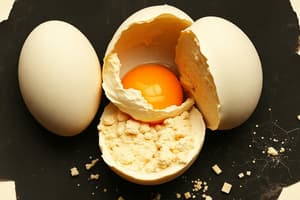Podcast
Questions and Answers
What is the role of hydrochloric acid in protein digestion?
What is the role of hydrochloric acid in protein digestion?
- Denatures protein and opens up folded structure (correct)
- Breaks proteins into single amino acids
- Converts pepsin to pepsinogen
- Controls the production of hydrochloric acid
Which enzyme is responsible for breaking tripeptides and dipeptides into single amino acids?
Which enzyme is responsible for breaking tripeptides and dipeptides into single amino acids?
- Peptidases (correct)
- Gastrin
- Proteases
- Pepsin
What is the function of pepsin in protein digestion?
What is the function of pepsin in protein digestion?
- Converts pepsinogen to pepsin
- Breaks proteins into single amino acids (correct)
- Controls the production of hydrochloric acid
- Denatures protein
In protein digestion, where do amino acids go after being absorbed by enterocytes of the intestine?
In protein digestion, where do amino acids go after being absorbed by enterocytes of the intestine?
What is the impact of consuming too much protein on kidney health?
What is the impact of consuming too much protein on kidney health?
What is the primary function of gastrin in the stomach?
What is the primary function of gastrin in the stomach?
What is one potential consequence of a vegetarian diet according to the text?
What is one potential consequence of a vegetarian diet according to the text?
Which of the following statements about the composition of proteins is correct?
Which of the following statements about the composition of proteins is correct?
How many different amino acids are typically used to make proteins in the human body?
How many different amino acids are typically used to make proteins in the human body?
Which of the following amino acids is classified as an essential amino acid?
Which of the following amino acids is classified as an essential amino acid?
What is the term used to describe the process of combining two incomplete protein sources to create a complete protein?
What is the term used to describe the process of combining two incomplete protein sources to create a complete protein?
Which of the following is an example of complementary proteins mentioned in the text?
Which of the following is an example of complementary proteins mentioned in the text?
In which organ does the digestion of proteins primarily occur?
In which organ does the digestion of proteins primarily occur?
Which of the following amino acids is classified as a dispensable amino acid?
Which of the following amino acids is classified as a dispensable amino acid?
What is the term used to describe amino acids that the body cannot produce or produces in low quantities, and must be obtained from food?
What is the term used to describe amino acids that the body cannot produce or produces in low quantities, and must be obtained from food?
Which of the following statements about complete proteins is true?
Which of the following statements about complete proteins is true?
According to the information provided, which of the following statements is correct about the digestion of proteins?
According to the information provided, which of the following statements is correct about the digestion of proteins?
Which of the following statements about kwashiorkor is true?
Which of the following statements about kwashiorkor is true?
What is the recommended daily intake of sodium for adult males according to the given information?
What is the recommended daily intake of sodium for adult males according to the given information?
Which of the following statements about vitamin E is incorrect?
Which of the following statements about vitamin E is incorrect?
Which of the following electrolytes is essential for the transmission of nerve impulses and muscle contractions?
Which of the following electrolytes is essential for the transmission of nerve impulses and muscle contractions?
What is the primary function of vitamin D in the body?
What is the primary function of vitamin D in the body?
Which of the following statements about beta-carotene is true?
Which of the following statements about beta-carotene is true?
Which of the following minerals is essential for the remodeling of bones and assisting in the production of osteocalcin?
Which of the following minerals is essential for the remodeling of bones and assisting in the production of osteocalcin?
What is the primary cause of hyponatremia (low blood sodium concentration)?
What is the primary cause of hyponatremia (low blood sodium concentration)?
Which of the following statements about magnesium is incorrect?
Which of the following statements about magnesium is incorrect?
Which of the following conditions is characterized by low bone mass and deterioration of bone tissue, leading to an increased risk of fractures?
Which of the following conditions is characterized by low bone mass and deterioration of bone tissue, leading to an increased risk of fractures?
Flashcards are hidden until you start studying
Study Notes
Enzymes and Protein Digestion
- Enzymes break down proteins into peptides and amino acids in the stomach and small intestine
- Hydrochloric acid denatures proteins, allowing access for digestion
- Pepsin breaks apart proteins into single amino acids and shorter polypeptides
- Gastrin regulates the production of hydrochloric acid and pepsin release in the stomach
- Enzymes in the small intestine break down polypeptides into single amino acids
- The pancreas and small intestine secrete enzymes called proteases that break proteins into peptides and single amino acids
Vegetarian Diets
- 2.3% of Canadians identify as vegan
- Vegetarian diets:
- Reduce intake of fat and total energy, reducing the risk of obesity and type 2 diabetes
- Lower blood pressure
- Reduce the risk of heart disease
- Reduce the risk of certain cancers (colorectal)
- Reduce the risk of kidney stones and gallstones
- However, vegetarian diets may lack certain vitamins and minerals and may require supplementation
Protein-Energy Malnutrition
- Kwashiorkor: a form of protein-energy malnutrition characterized by wasting and edema, typically seen in children 1-3 years old who no longer receive breast milk and have a low protein intake
- Marasmus: a disease caused by inadequate energy intake, especially protein, most common in children 6-18 months old in impoverished conditions
Fluids and Electrolytes
- Water intake recommendations:
- Men (19-50): 3.7 L of total water/day (3.0 L from beverages, 0.7 L from food)
- Women (19-50): 2.7 L of total water/day (2.0 L from beverages, 0.7 L from food)
- Athletes and people working in hot environments may require more water
- Fluid and electrolyte balance is crucial to maintain proper bodily functions
Electrolytes
- Sodium (Na):
- Intakes: Females → 1500 mg/d, Males → 1500 mg/d
- Functions: fluid and electrolyte balance, blood pressure regulation, nerve impulse transmission, muscle contraction
- High sodium intake can lead to hypertension
- Chloride (Cl):
- Intakes: Females → 2300 mg/d, Males → 2300 mg/d
- Functions: fluid and electrolyte balance
- Potassium (K):
- Lab range: 3.5-5.0 mmol/L
- Intakes: Females → 2600 mg/d, Males → 3400 mg/d
- Functions: fluid and electrolyte balance, transmission of nerve impulses, muscle contractions
- High-potassium diets can lower blood pressure
- Phosphorus (H0P4):
- Intakes: Females → 700 mg/d, Males → 700 mg/d
- Functions: fluid balance, bone formation, enzyme activation, DNA and RNA synthesis
- High phosphorus levels can occur in people with kidney disease, vitamin D excess, and phosphorus-containing antacids
Antioxidants
- Oxidation: a chemical reaction where atoms lose electrons
- Antioxidants: molecules that donate electrons to free radicals
- Vitamin E:
- Functions: antioxidant, cell membrane protection, nerve and muscle function
- RDA: 15 mg alpha-tocopherol
- Deficiency: erythrocyte hemolysis, loss of muscle coordination, poor immune function
- Vitamin C:
- Functions: antioxidant, collagen synthesis, hormone synthesis, immune function
- Functions: antioxidant, enhance immune function, protect against LDL oxidation
- Beta-Carotene:
- Functions: antioxidant, immune function, skin and eye protection
- 12 units of beta-carotene = 1 unit of vitamin A
- Selenium:
- Functions: antioxidant, thyroid hormone production, immune function
- Deficiency: Keshan disease
Bone Health
- Calcium:
- RDA: 19-50: 1000mg/day, Women 51+: 1200mg/day, Men 51-70: 1000mg/day, 70+: 1200mg/day
- Functions: bone formation and maintenance, acid-base balance, muscle contraction, nerve function
- Deficiency: osteoporosis, increased fracture risk
- Vitamin D:
- Functions: calcium regulation, bone health
- Deficiency: osteomalacia (soft bones)
- Vitamin K:
- Functions: bone remodeling, blood clotting
- Deficiency: inability of blood to clot
- Phosphorus:
- Functions: critical for bone mineral composition, enzyme activation, ATP production
- Deficiency: rare but can occur in people with kidney disease, chronic diarrhea, and malnourished elderly adults
- Magnesium:
- Functions: bone health, hydroxyapatite formation, ATP production, heart health
- Deficiency: secondary to kidney disease, chronic diarrhea, alcohol abuse
Diseases of the Bone
- Osteoporosis:
- Low bone mass and deterioration of bone tissue, leading to increased fracture risk
- Influences on osteoporosis risk: aging, hormonal changes, smoking, low body weight, low calcium intake, low sun exposure, alcohol abuse, history of amenorrhea, estrogen deficiency, testosterone deficiency, repeated falls, sedentary lifestyle, long-time use of glucocorticoids
- Osteomalacia:
- Softening of bones in adults due to vitamin D deficiency
Studying That Suits You
Use AI to generate personalized quizzes and flashcards to suit your learning preferences.




